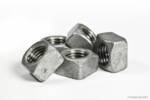Newest FAQs
No. As a matter of fact, nobody does. The ASTM F3125 grade A325 specification clearly denotes the diameter range of this grade of fastener to be ½” through 1-1/2” inclusive. Therefore, an A325 bolt larger than 1-1/2” diameter simply does not exist. It cannot be manufactured because there are no dimensional or strength requirements for... Read more
We’ll try our best. The relationship between tension and torque should be looked at cautiously, since it is very difficult to indicate the range of conditions expected to be experienced by a fastener. Torque is simply a measure of the twisting force required to spin the nut up along the threads of a bolt, whereas... Read more

Engineers occasionally specify the use of F3125 Grade A325 heavy hex structural bolts as anchor bolts, but technically they are supposed to be used for structural steel connections only. Part of the problem is that the A325 specification is very specific as to the application and thread length. Because A325 bolts are typically used in... Read more
Frequently, imported mild steel all thread rod will not meet ASTM A307 grade C. The three different grades of the A307 specification identify their intended application where grade C is embedded in concrete and used for anchoring purposes, grade B is used in cast iron flange connections, and grade A covers general applications. Normally, imported... Read more
First, unlike tensile and yield strengths, there are no published shear strength values or requirements for ASTM specifications. The Industrial Fastener Institute (Inch Fastener Standards, 7th ed. 2003. B-8) states that shear strength is approximately 60% of the minimum tensile strength. “As an empirical guide, shear strengths of carbon steel fasteners may be assumed to... Read more
Contrary to popular belief, roll threaded anchor bolts are acceptable for schools in California when connecting steel to concrete. Portland bolt spent three years working with the California Department of General Services Division of the State Architect to dispel the rumor that only full body cut threaded bolts could be used. The link at the... Read more
No. Hot-dip galvanized nuts need to be used with hot-dip galvanized bolts since galvanized nuts are tapped oversize to accommodate for the extra 2 – 6 mils (.002 – .006) of zinc that is added to the threads of the bolt during the galvanizing process. A common misconception is that bolts that are going to... Read more

